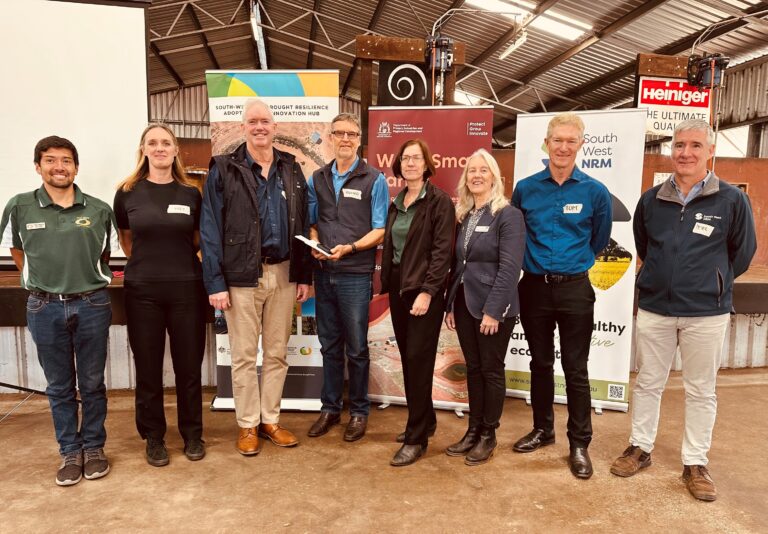
Rhodes Pastoral General Manager Michael Wright (third from left) at the Preparing for Drought Workshop in October, 2024.
Average annual rainfall on the 16,000 hectare Rhodes Pastoral property Michael Wright manages near Boyup Brook has dropped well below 500mm in the past decade.
That’s a problem on a mixed livestock and cropping operation with 52,000 sheep and 1,500 cattle (in winter) with a big need for a lot of fresh water.
With the challenges of a drying climate compounded by innovations such as knife-points reducing runoff from hillslopes, Michael has had to pay more attention to water capture and conservation.
He spoke at our Rylington Park Preparing for Drought Workshop back in October about his approach to water security.
“In livestock farming, investment in water security is very important, so in the tough times, you’re not forced to sell stock because you’ve run out of water,” he said on the day.
“You’ve got to sell stock when you want to, not when you have to.
“So, dams and catchments are just as important as genetics and machinery, and you need to put a bit of money aside each year to do annual maintenance and improvement.
“You try to improve the genetics of your flock, but If you haven’t got quality water, they’re not going to improve. They can’t grow, get pregnant, or rear those calves or lambs the way they should if they haven’t got good quality water that is kept cool.
“Livestock hate hot water. So I look at water as the genetics of the land.
“Quality water, particularly through summer gives you performance with your genetics. Rubbish water doesn’t. So you need quality water and good water infrastructure.
“Anything you do to improve water infrastructure, whether it’s cleaning or extending a bank, putting in a soak or silt trap, is adding value to the business.”
In the process of drought-proofing the business, Michael has taught himself to water divine and recommends others give it a go. He always carries a salt meter, so if he comes across a seep, he digs down a little and checks the salt levels.
In some cases where he has found clean water he has built a dam.
“You’ve got to know what you’re dealing with,” he said.
“If you don’t understand your water quality, you’re not in the game.”
Michael’s tips and practices:
- Flat-bottomed drains about 3 metres wide and 200-300m long with batters on each side have been built on a slight grade into dams. The slight grade ensures water flows rather than seeping into the bank and potentially causing a salt scald.
- Banks / drains are maintained every year or two to maximise flow rates and achieve runoff in smaller rain events (e.g. grade or spray weeds).
- Other options include capturing water from roads or laneways or roaded catchments.
- Consider silt traps in front of dams so you never have to clean the dam out.
- Fence off larger key dams, e.g. 20,000 cubic metres, from livestock to avoid spoiling water with their faeces.
- Key dams can store water to pump to a tank at the highest point on the property and from there, gravity-feed across the whole farm. Michael uses a pump and solar panel that can shift 80,000 litres of water a day.
- Solar panels need to be cleaned every two months to remain effective.
- Water pipes are buried 500mm deep to avoid water getting too hot.
- Water can be piped to “cup and saucer” troughs or other tanks, rather than dams that evaporate.
- Cup and saucer trough systems keep water cooler compared to open troughs. Michael puts them on concrete (or use gravel) to reduce dust contaminating the water. These are cleaned out once a week.
- Get help from contractors to find the right soil type for new dams.
- Capture water from sheds and houses. Fix leaking gutters to maximise capture.
- Know your salinity levels so you understand what stock are drinking.
The Preparing for Drought event was coordinated by South West NRM in collaboration with Edith Cowan University (ECU) and the Shire of Boyup Brook. South West NRM and PHCC are the Peel and South West Node of the South-West WA Drought Resilience Adoption and Innovation Hub and receives funding from the Australian Government’s Future Drought Fund.
Watch other presentations from the event via the below buttons.



